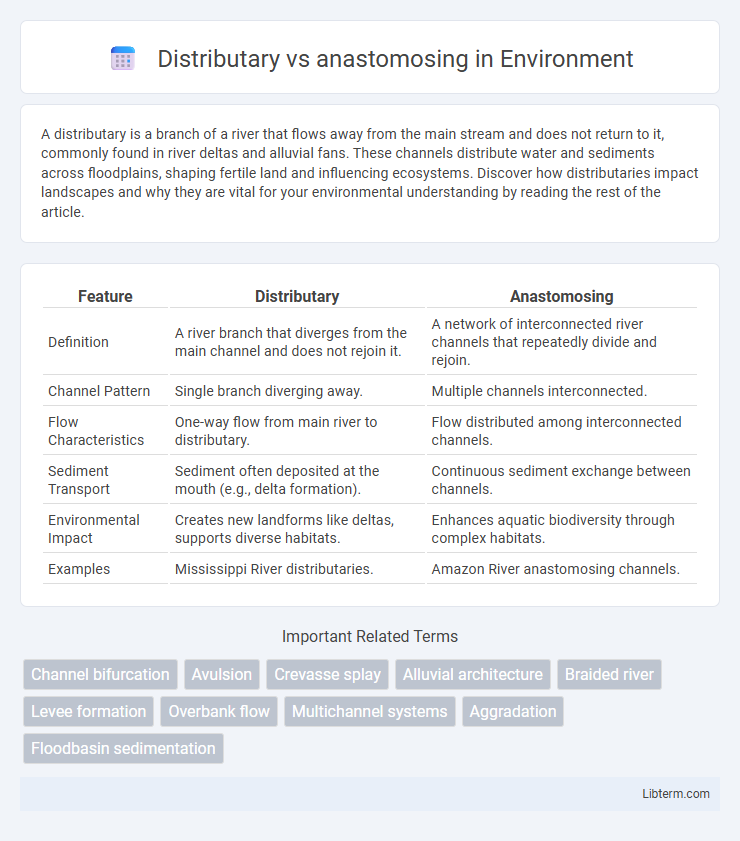A distributary is a branch of a river that flows away from the main stream and does not return to it, commonly found in river deltas and alluvial fans. These channels distribute water and sediments across floodplains, shaping fertile land and influencing ecosystems. Discover how distributaries impact landscapes and why they are vital for your environmental understanding by reading the rest of the article.
Table of Comparison
| Feature | Distributary | Anastomosing |
|---|---|---|
| Definition | A river branch that diverges from the main channel and does not rejoin it. | A network of interconnected river channels that repeatedly divide and rejoin. |
| Channel Pattern | Single branch diverging away. | Multiple channels interconnected. |
| Flow Characteristics | One-way flow from main river to distributary. | Flow distributed among interconnected channels. |
| Sediment Transport | Sediment often deposited at the mouth (e.g., delta formation). | Continuous sediment exchange between channels. |
| Environmental Impact | Creates new landforms like deltas, supports diverse habitats. | Enhances aquatic biodiversity through complex habitats. |
| Examples | Mississippi River distributaries. | Amazon River anastomosing channels. |
Introduction to River Systems
Distributary river systems feature channels that branch off from the main river and flow away, commonly found in delta formations where sediment deposition causes the river to split. Anastomosing rivers consist of multiple interconnected channels that separate and rejoin, often flowing through vegetated floodplains with stable banks supported by cohesive sediments. Understanding the differences between distributary and anastomosing patterns is essential for analyzing sediment transport, flood dynamics, and habitat diversity within fluvial environments.
Definition of Distributary Channels
Distributary channels are smaller streams or tributaries that branch off and flow away from the main river channel, typically found in delta regions where the river splits into multiple pathways. These channels distribute water and sediment across a delta, facilitating the formation of complex, multi-channeled depositional environments. Distributary channels differ from anastomosing rivers, which consist of multiple interconnected channels separated by stable, often vegetated islands within a single river system.
Definition of Anastomosing Channels
Anastomosing channels are a network of interconnected, stable river channels separated by floodplain areas, often characterized by cohesive banks and low channel mobility. These channels differ from distributary channels, which are individual branching streams diverging from a main river without reconnecting. Anastomosing systems typically form in low-gradient environments with abundant sediment supply, promoting multiple intertwined waterways that facilitate sediment deposition and floodplain development.
Key Differences Between Distributary and Anastomosing
Distributary channels diverge from a main river channel, typically found in delta regions where sediment deposition splits flow into multiple branches, while anastomosing channels are characterized by multiple interconnected and stable channels separated by vegetated islands, often occurring in alluvial plains. Distributary systems generally promote sediment dispersal toward the sea, whereas anastomosing rivers maintain complex channel networks that reduce flow velocity and sustain wetland habitats. The primary difference lies in the permanence and connectivity of channels: distributaries form distinct, isolated branches, whereas anastomosing channels exhibit persistent, overlapping pathways with dynamic water exchange.
Formation Processes of Distributary Networks
Distributary networks form when a river channel bifurcates due to sediment deposition that obstructs flow, causing water to split and create multiple smaller channels that spread outward, often in deltaic environments. Anastomosing networks develop through repeated channel avulsions and floodplain sedimentation, where stable, interconnecting channels are separated by cohesive, vegetated floodplains, promoting lateral stability and multi-threaded flow patterns. The formation of distributary systems is primarily driven by sediment load and flow division, whereas anastomosing systems rely on floodplain dynamics and channel stability mechanisms.
Formation Processes of Anastomosing Networks
Anastomosing river networks form through the process of channel splitting and rejoining around stable floodplain islands with cohesive bank materials, resulting in multiple interconnected channels. These networks develop in low-gradient environments with abundant fine sediment and persistent overbank flooding, which encourages sediment deposition and channel stabilization. Unlike distributary systems that diverge from a single source, anastomosing channels maintain connectivity and dynamic equilibrium across a complex braided pattern.
Ecological Significance of Distributary Systems
Distributary systems create diverse aquatic habitats by directing water flow into multiple channels, promoting nutrient distribution and sediment deposition essential for wetland sustainability. These networks support rich biodiversity by forming dynamic environments for fish spawning, bird nesting, and plant growth, enhancing ecosystem resilience. Their role in flood mitigation and groundwater recharge further underscores their critical ecological importance.
Ecological Importance of Anastomosing Rivers
Anastomosing rivers support diverse aquatic habitats by creating stable floodplains with interconnected channels that enhance nutrient cycling and sediment retention. These complex networks foster high biodiversity, including riparian vegetation and fish populations, by providing varied ecological niches and refuges during floods. Their ecological importance lies in maintaining watershed health and resilience, with significant roles in groundwater recharge and carbon sequestration.
Real-World Examples and Locations
Distributary river systems, such as the Mississippi River Delta in the United States, feature multiple channels splitting from the main river, distributing sediment and water across the delta plain. Anastomosing rivers, exemplified by the Magdalena River in Colombia, consist of stable, interconnected channels separated by vegetated islands, creating complex floodplains with low-gradient flows. These differences influence flood management strategies and ecological diversity, with distributary systems promoting sediment deposition and delta growth, while anastomosing networks support rich wetland habitats through their interconnected channels.
Conclusion: Choosing the Right Term
Distributary refers to a channel that branches off from the main river and flows away, typically found in delta regions, while anastomosing describes a network of multiple interconnected channels separated by stable, vegetated islands. Selecting the correct term depends on the river's morphology and hydrodynamics: distributaries emphasize branching and sediment deposition patterns, whereas anastomosing systems highlight channel interconnection and stability. Accurate terminology ensures effective communication in fluvial geomorphology and river management studies.
Distributary Infographic

 libterm.com
libterm.com